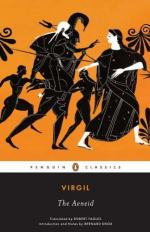|
This section contains 256 words (approx. 1 page at 400 words per page) |

|
The Aeneid Summary & Study Guide Description
The Aeneid Summary & Study Guide includes comprehensive information and analysis to help you understand the book. This study guide contains the following sections:
This detailed literature summary also contains Further Study and a Free Quiz on The Aeneid by Virgil.
When Virgil was dying in 17 BC he asked for the unfinished Aeneid to be destroyed. The emperor Augustus refused the request. This decision affected the course of literary history and the development of western culture. Even in his own lifetime Virgil's poetry had become a school text. Early Christian writers who attempted to reject Virgil could escape neither his style nor his attitudes. Christian thought assimilated them both. The Aeneid and the Bible were probably the two most consistently read books in Western Europe for two thousand years.
The Aeneid was composed at least in part to celebrate "truth, justice, and the Roman way" and to promote the rebirth of the Roman way of life under Augustus. The Aeneid also universalizes Roman experience, ideals, and aspirations. The Aeneid represents a pivotal point in western literature: Virgil drew on the whole of Greek and Latin literature to create this epic. He expanded the range of the Latin epic, using elements from most types of late classical literature, while refining the linguistic and metrical possibilities of the epic genre. Because of its generic inclusiveness and linguistic brilliance, the Aeneid spread its influence across every form of written discourse for centuries.
In the last two thousand years the Aeneid has been a pagan bible, a Latin style manual, a moral allegory, a document of European unity, a pacifist document - and one of the most-read and studied works of world literature of all time. Entering its third millennium, the Aeneid can still speak immediately to the reader.
Read more from the Study Guide
|
This section contains 256 words (approx. 1 page at 400 words per page) |

|



